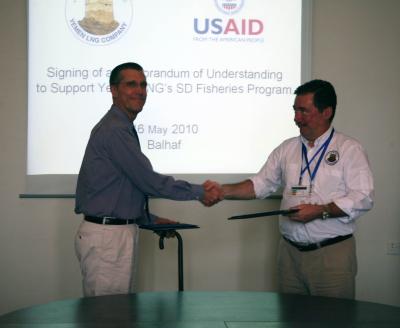Yemen LNG and USAID Sign a Memorandum of Understanding (MoU)

16 May 2010
Yemen LNG Company and the United States Agency for International Development (USAID) have signed today a Memorandum of Understanding (MoU) in support of Yemen LNG’s Sustainable Fisheries Program in the coastal areas around Balhaf, Shabwa Governorate.
The MoU was signed at Balhaf by Mr. Francois Rafin, Yemen LNG’s General Manager and Dr. Jeff Ashley, USAID Mission Director.
François Rafin, General Manager of Yemen LNG said “More security at sea, improved welfare in the villages i.e. water, electricity, health care, schools, improved fish stock resources and jobs at the Yemen LNG plant – these are the goals of Yemen LNG and of the fishermen communities. We welcome USAID monitoring the fish stock with scientific technology”.
Yemen LNG’s 5-Year Sustainable Community Development Program includes a Fisheries Program to help fishermen increasing fish catches in the offshore region and reducing unsustainable fishing pressure on the coastal and coral associated fisheries to support coastal communities neighboring Yemen LNG operations. The installation of Fish Aggregation Devices (FADs) in the project area proofed to be highly successful in attracting pelagic fish, including Long tail and Yellow fin tuna, opening up new fishing opportunities from a shared resource with other countries of the Indian Ocean Region.
A FAD is an artificial object that is specifically designed and located to attract fish. FADs create fishing grounds and serve as an effective means to increase local fish catches. A FAD comprises a large buoy and a mat that is anchored to the sea floor by a cable and concrete block. FADs create an environment suitable for plankton and algal growth, which attracts fish. The FADs do not necessarily increase the overall fish abundance in a given area, but rather gather fish from a large area to a smaller concentrated area, thereby allowing the fishermen to concentrate their fishing activities in a specific location. Overall fish catches and catch rates around the FADs tend to be higher than in open-water areas, due to this fish concentration. Different fish species aggregate and circulate around the FADs at various distances, directions and depths.
To determine what effect the FAD deployment is having on the Al Ayn Bay, a study was developed using forms to register data of all fish landed and auctioned. Fisheries data collected from the 3 pilot phase FADs during 2008 showed that the FAD fishery was landing more fish than the traditional fishery fished away from the FADs. Following success of the pilot phase FADs project that included 3 devices, Yemen LNG installed nine more FADs during 2009 that provided increased fishing opportunities from sustainable fish stocks, reduced operating costs and improved markets and income to the Al Ayn Bay and Bir Ali based fishermen. Data analyses done for 2009 shows that the FAD fishery is now a significant part of the fishermen’s income since the beginning of 2008. Feedback from the local fishermen on the performance of the FADs is positive. They said the FADs have helped and compensated them to a big extent and that they have now been able to catch rare types of fish that were not able to catch before.
MacAlister, Elliott and Partners (MEP), a UK based Consulting Company have been responsible for the implementation of Yemen LNG’s FADs project which includes installation of devices on the sea and data collection and analysis of fish landed by fishermen.
USAID supports the government of Yemen in the fields of governance, health, education and economic growth. The Agency targets five governorates which are Saada, Amran, Al-Jawf, Marib and Shabwa. USAID through its partnership with YLNG aims to improve the lives of residents in and around Balhaf through the creation of new livelihoods opportunities. As USAID is engaged in a range of development activities in Yemen, it intends to leverage its expertise and resources by collaborating with Yemen LNG on its Fisheries Program in support of Yemen’s coastal communities. The USAID sponsorship underscores the success of Yemen LNG’s FADs project. USAID as a first rank US agency will sponsor the monitoring of the impact of the FADs project using new fish landing data system technology. This independent evaluation using scientific tools will provide extremely useful information for the steering of the fisheries SD projects.
Next to the Balhaf LNG plant, the fishermen villages of Bir Ali and Jela’a are inhabited by 3000 people. Yemen LNG carried out a fishermen compensation program of US$ 2.5m and constructed new breakwaters at Jela’a to mitigate the installation of the Yemen LNG terminal. Sustainable development programs started with the installation of Fish Aggregation Devices to increase the fish catch and to allow fishing in safe coastal waters. Additional programs included water supply, road construction, power generation, food supply, environmental protection and schools. Yemen LNG and the fishermen communities share common goals in the preservation of the coastal and marine environment and in the protection from piracy.
Other sustainable development programs undertaken by Yemen LNG in its project neighboring communities around its project include economic programs including beekeeping and agriculture; social programs including health, education and women and vulnerability alleviation programs including water and electricity. Thirty employment opportunities are now in the process for Jela’ah and Bir Ali communities at the Yemen LNG Balhaf plant.